Minseok Seo
AIS-LLM: A Unified Framework for Maritime Trajectory Prediction, Anomaly Detection, and Collision Risk Assessment with Explainable Forecasting
Aug 11, 2025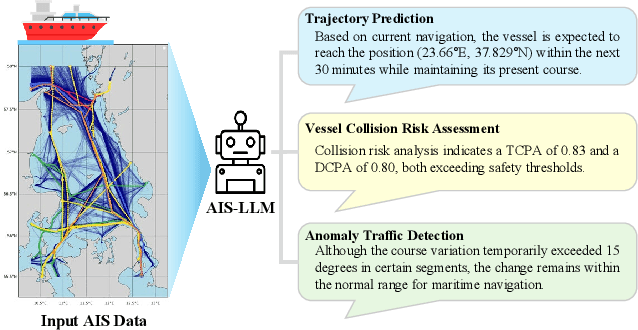

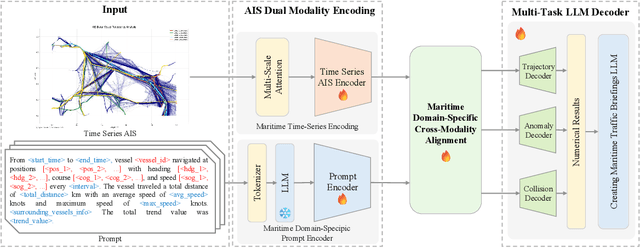

Abstract:With the increase in maritime traffic and the mandatory implementation of the Automatic Identification System (AIS), the importance and diversity of maritime traffic analysis tasks based on AIS data, such as vessel trajectory prediction, anomaly detection, and collision risk assessment, is rapidly growing. However, existing approaches tend to address these tasks individually, making it difficult to holistically consider complex maritime situations. To address this limitation, we propose a novel framework, AIS-LLM, which integrates time-series AIS data with a large language model (LLM). AIS-LLM consists of a Time-Series Encoder for processing AIS sequences, an LLM-based Prompt Encoder, a Cross-Modality Alignment Module for semantic alignment between time-series data and textual prompts, and an LLM-based Multi-Task Decoder. This architecture enables the simultaneous execution of three key tasks: trajectory prediction, anomaly detection, and risk assessment of vessel collisions within a single end-to-end system. Experimental results demonstrate that AIS-LLM outperforms existing methods across individual tasks, validating its effectiveness. Furthermore, by integratively analyzing task outputs to generate situation summaries and briefings, AIS-LLM presents the potential for more intelligent and efficient maritime traffic management.
Data-driven Precipitation Nowcasting Using Satellite Imagery
Dec 16, 2024Abstract:Accurate precipitation forecasting is crucial for early warnings of disasters, such as floods and landslides. Traditional forecasts rely on ground-based radar systems, which are space-constrained and have high maintenance costs. Consequently, most developing countries depend on a global numerical model with low resolution, instead of operating their own radar systems. To mitigate this gap, we propose the Neural Precipitation Model (NPM), which uses global-scale geostationary satellite imagery. NPM predicts precipitation for up to six hours, with an update every hour. We take three key channels to discriminate rain clouds as input: infrared radiation (at a wavelength of 10.5 $\mu m$), upper- (6.3 $\mu m$), and lower- (7.3 $\mu m$) level water vapor channels. Additionally, NPM introduces positional encoders to capture seasonal and temporal patterns, accounting for variations in precipitation. Our experimental results demonstrate that NPM can predict rainfall in real-time with a resolution of 2 km. The code and dataset are available at https://github.com/seominseok0429/Data-driven-Precipitation-Nowcasting-Using-Satellite-Imagery.
Masked Autoregressive Model for Weather Forecasting
Sep 30, 2024Abstract:The growing impact of global climate change amplifies the need for accurate and reliable weather forecasting. Traditional autoregressive approaches, while effective for temporal modeling, suffer from error accumulation in long-term prediction tasks. The lead time embedding method has been suggested to address this issue, but it struggles to maintain crucial correlations in atmospheric events. To overcome these challenges, we propose the Masked Autoregressive Model for Weather Forecasting (MAM4WF). This model leverages masked modeling, where portions of the input data are masked during training, allowing the model to learn robust spatiotemporal relationships by reconstructing the missing information. MAM4WF combines the advantages of both autoregressive and lead time embedding methods, offering flexibility in lead time modeling while iteratively integrating predictions. We evaluate MAM4WF across weather, climate forecasting, and video frame prediction datasets, demonstrating superior performance on five test datasets.
ACE Metric: Advection and Convection Evaluation for Accurate Weather Forecasting
Jun 07, 2024Abstract:Recently, data-driven weather forecasting methods have received significant attention for surpassing the RMSE performance of traditional NWP (Numerical Weather Prediction)-based methods. However, data-driven models are tuned to minimize the loss between forecasted data and ground truths, often using pixel-wise loss. This can lead to models that produce blurred outputs, which, despite being significantly different in detail from the actual weather conditions, still demonstrate low RMSE values. Although evaluation metrics from the computer vision field, such as PSNR, SSIM, and FVD, can be used, they are not entirely suitable for weather variables. This is because weather variables exhibit continuous physical changes over time and lack the distinct boundaries of objects typically seen in computer vision images. To resolve these issues, we propose the advection and convection Error (ACE) metric, specifically designed to assess how well models predict advection and convection, which are significant atmospheric transfer methods. We have validated the ACE evaluation metric on the WeatherBench2 and MovingMNIST datasets.
Long-Term Typhoon Trajectory Prediction: A Physics-Conditioned Approach Without Reanalysis Data
Jan 28, 2024Abstract:In the face of escalating climate changes, typhoon intensities and their ensuing damage have surged. Accurate trajectory prediction is crucial for effective damage control. Traditional physics-based models, while comprehensive, are computationally intensive and rely heavily on the expertise of forecasters. Contemporary data-driven methods often rely on reanalysis data, which can be considered to be the closest to the true representation of weather conditions. However, reanalysis data is not produced in real-time and requires time for adjustment because prediction models are calibrated with observational data. This reanalysis data, such as ERA5, falls short in challenging real-world situations. Optimal preparedness necessitates predictions at least 72 hours in advance, beyond the capabilities of standard physics models. In response to these constraints, we present an approach that harnesses real-time Unified Model (UM) data, sidestepping the limitations of reanalysis data. Our model provides predictions at 6-hour intervals for up to 72 hours in advance and outperforms both state-of-the-art data-driven methods and numerical weather prediction models. In line with our efforts to mitigate adversities inflicted by \rthree{typhoons}, we release our preprocessed \textit{PHYSICS TRACK} dataset, which includes ERA5 reanalysis data, typhoon best-track, and UM forecast data.
A Multi-In-Single-Out Network for Video Frame Interpolation without Optical Flow
Dec 05, 2023Abstract:In general, deep learning-based video frame interpolation (VFI) methods have predominantly focused on estimating motion vectors between two input frames and warping them to the target time. While this approach has shown impressive performance for linear motion between two input frames, it exhibits limitations when dealing with occlusions and nonlinear movements. Recently, generative models have been applied to VFI to address these issues. However, as VFI is not a task focused on generating plausible images, but rather on predicting accurate intermediate frames between two given frames, performance limitations still persist. In this paper, we propose a multi-in-single-out (MISO) based VFI method that does not rely on motion vector estimation, allowing it to effectively model occlusions and nonlinear motion. Additionally, we introduce a novel motion perceptual loss that enables MISO-VFI to better capture the spatio-temporal correlations within the video frames. Our MISO-VFI method achieves state-of-the-art results on VFI benchmarks Vimeo90K, Middlebury, and UCF101, with a significant performance gap compared to existing approaches.
Deterministic Guidance Diffusion Model for Probabilistic Weather Forecasting
Dec 05, 2023



Abstract:Weather forecasting requires not only accuracy but also the ability to perform probabilistic prediction. However, deterministic weather forecasting methods do not support probabilistic predictions, and conversely, probabilistic models tend to be less accurate. To address these challenges, in this paper, we introduce the \textbf{\textit{D}}eterministic \textbf{\textit{G}}uidance \textbf{\textit{D}}iffusion \textbf{\textit{M}}odel (DGDM) for probabilistic weather forecasting, integrating benefits of both deterministic and probabilistic approaches. During the forward process, both the deterministic and probabilistic models are trained end-to-end. In the reverse process, weather forecasting leverages the predicted result from the deterministic model, using as an intermediate starting point for the probabilistic model. By fusing deterministic models with probabilistic models in this manner, DGDM is capable of providing accurate forecasts while also offering probabilistic predictions. To evaluate DGDM, we assess it on the global weather forecasting dataset (WeatherBench) and the common video frame prediction benchmark (Moving MNIST). We also introduce and evaluate the Pacific Northwest Windstorm (PNW)-Typhoon weather satellite dataset to verify the effectiveness of DGDM in high-resolution regional forecasting. As a result of our experiments, DGDM achieves state-of-the-art results not only in global forecasting but also in regional forecasting. The code is available at: \url{https://github.com/DongGeun-Yoon/DGDM}.
Prototype-oriented Unsupervised Change Detection for Disaster Management
Oct 17, 2023


Abstract:Climate change has led to an increased frequency of natural disasters such as floods and cyclones. This emphasizes the importance of effective disaster monitoring. In response, the remote sensing community has explored change detection methods. These methods are primarily categorized into supervised techniques, which yield precise results but come with high labeling costs, and unsupervised techniques, which eliminate the need for labeling but involve intricate hyperparameter tuning. To address these challenges, we propose a novel unsupervised change detection method named Prototype-oriented Unsupervised Change Detection for Disaster Management (PUCD). PUCD captures changes by comparing features from pre-event, post-event, and prototype-oriented change synthesis images via a foundational model, and refines results using the Segment Anything Model (SAM). Although PUCD is an unsupervised change detection, it does not require complex hyperparameter tuning. We evaluate PUCD framework on the LEVIR-Extension dataset and the disaster dataset and it achieves state-of-the-art performance compared to other methods on the LEVIR-Extension dataset.
Improved Flood Insights: Diffusion-Based SAR to EO Image Translation
Jul 14, 2023



Abstract:Driven by rapid climate change, the frequency and intensity of flood events are increasing. Electro-Optical (EO) satellite imagery is commonly utilized for rapid response. However, its utilities in flood situations are hampered by issues such as cloud cover and limitations during nighttime, making accurate assessment of damage challenging. Several alternative flood detection techniques utilizing Synthetic Aperture Radar (SAR) data have been proposed. Despite the advantages of SAR over EO in the aforementioned situations, SAR presents a distinct drawback: human analysts often struggle with data interpretation. To tackle this issue, this paper introduces a novel framework, Diffusion-Based SAR to EO Image Translation (DSE). The DSE framework converts SAR images into EO images, thereby enhancing the interpretability of flood insights for humans. Experimental results on the Sen1Floods11 and SEN12-FLOOD datasets confirm that the DSE framework not only delivers enhanced visual information but also improves performance across all tested flood segmentation baselines.
VisDA 2022 Challenge: Domain Adaptation for Industrial Waste Sorting
Mar 26, 2023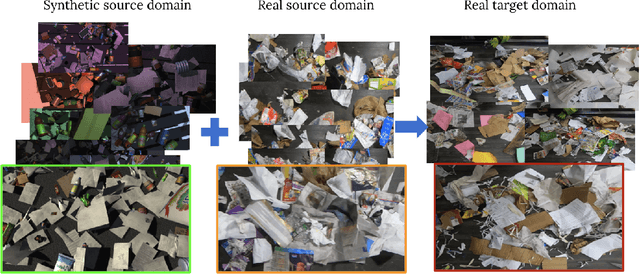
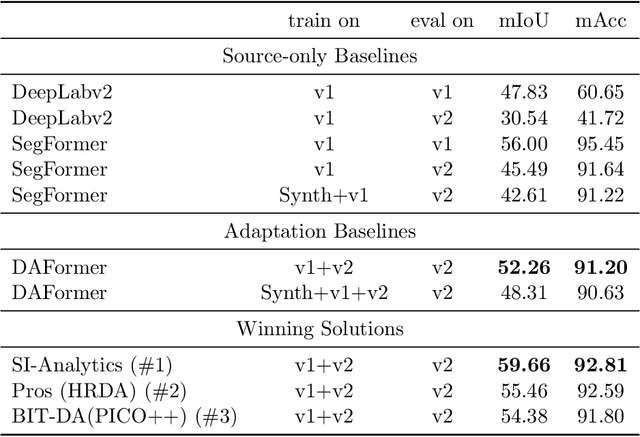
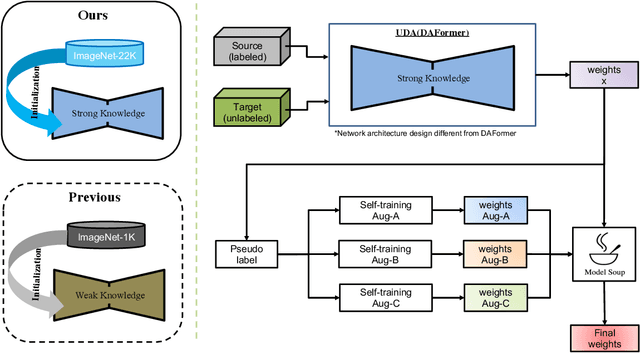

Abstract:Label-efficient and reliable semantic segmentation is essential for many real-life applications, especially for industrial settings with high visual diversity, such as waste sorting. In industrial waste sorting, one of the biggest challenges is the extreme diversity of the input stream depending on factors like the location of the sorting facility, the equipment available in the facility, and the time of year, all of which significantly impact the composition and visual appearance of the waste stream. These changes in the data are called ``visual domains'', and label-efficient adaptation of models to such domains is needed for successful semantic segmentation of industrial waste. To test the abilities of computer vision models on this task, we present the VisDA 2022 Challenge on Domain Adaptation for Industrial Waste Sorting. Our challenge incorporates a fully-annotated waste sorting dataset, ZeroWaste, collected from two real material recovery facilities in different locations and seasons, as well as a novel procedurally generated synthetic waste sorting dataset, SynthWaste. In this competition, we aim to answer two questions: 1) can we leverage domain adaptation techniques to minimize the domain gap? and 2) can synthetic data augmentation improve performance on this task and help adapt to changing data distributions? The results of the competition show that industrial waste detection poses a real domain adaptation problem, that domain generalization techniques such as augmentations, ensembling, etc., improve the overall performance on the unlabeled target domain examples, and that leveraging synthetic data effectively remains an open problem. See https://ai.bu.edu/visda-2022/
 Add to Chrome
Add to Chrome Add to Firefox
Add to Firefox Add to Edge
Add to Edge